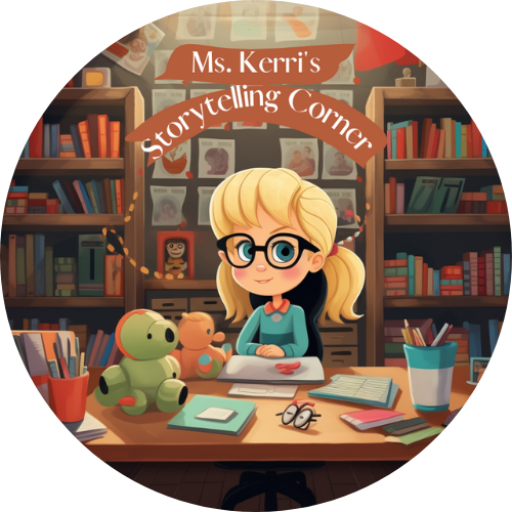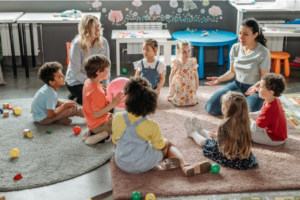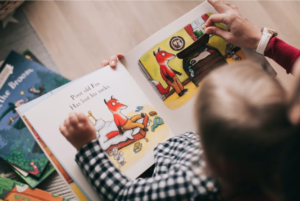Igniting the Flames of Imagination: Unleashing the Magic of Reading in KidsIntroduction
The Joyful Path to Literacy: Making Reading an Adventure for Kids
In a world dominated by screens and distractions, it is essential for parents and teachers to prioritize making reading fun for kids. When children associate reading with joy and excitement, they are more likely to develop a lifelong love for books and learning.
By creating a positive reading environment, we can nurture their imagination, enhance vocabulary skills, boost cognitive development, and foster empathy. In this article, we will explore tips and tricks that parents and teachers can employ to transform reading into an enjoyable adventure that captivates young minds.
Importance of Making Reading Fun for Kids
Reading is not just about decoding words on a page; it is an avenue of exploration, discovery, and personal growth. By making reading fun from an early age, we empower children to embark on this enchanting journey willingly.
When kids enjoy the process of reading—whether through engaging stories or interactive activities—they are more likely to choose books over screens or other distractions. Creating a positive association with reading can contribute to improved comprehension skills, increased attention span, enhanced creativity, and critical thinking abilities.
Benefits of Instilling a Love for Reading at an Early Age
Instilling a love for reading in children at an early age has numerous long-term advantages. Beyond the immediate joy it brings them, fostering this passion lays the foundation for academic success as they progress through school. Research suggests that children who develop strong literacy skills are better equipped to excel in all subjects across the curriculum.
Furthermore, avid readers tend to have higher levels of empathy as they immerse themselves in diverse characters’ lives and stories from around the world. Moreover, cultivating a love for books opens up limitless possibilities for self-expression and personal growth.
It encourages independent thinking while nurturing imagination and creativity—a crucial aspect of child development. Additionally, reading enhances vocabulary, language proficiency, and communication skills, enabling children to express themselves eloquently and confidently in both spoken and written forms.
By making reading fun for kids today, we are shaping a brighter future for them—one filled with intellectual curiosity, empathy towards others’ experiences, and a lifelong love affair with books. So let us embark on this delightful adventure together—immersing ourselves in the realm of imagination while guiding our young ones toward literacy triumphs.
Creating a Reading-Friendly Environment

Setting up a cozy and inviting reading nook
One of the first steps in making reading fun for kids is to create a cozy and inviting reading nook. This designated space should be visually appealing and comfortable, enticing children to curl up with a good book.
Start by choosing a corner or area in the house or classroom that is quiet and away from distractions. Add some soft pillows, cushions, or bean bags for seating options.
Consider using a small tent or canopy to create a private reading space that sparks imagination. Decorate the area with posters of beloved storybook characters or inspiring quotes about the wonders of reading.
Incorporating colorful and engaging book displays
A visually stimulating environment can greatly enhance children’s interest in reading. Incorporate colorful and engaging book displays that catch their attention as they enter the room.
Arrange books on low shelves, making it easy for little readers to pick out their favorites independently. You can organize books by genre, author, or theme to make browsing exciting.
Use attractive bookends, baskets, or bins to keep everything tidy and easily accessible. Don’t forget to regularly rotate books on display to keep things fresh and intriguing.
Using soft lighting and comfortable seating arrangements
The ambiance plays an essential role in creating an enjoyable reading experience for kids. Soft lighting can help set a calm mood conducive to diving into stories. Opt for warm-toned light bulbs instead of harsh fluorescent ones, which can be off-putting for young readers’ eyes.
Natural light is ideal during daytime hours as it creates an uplifting atmosphere but ensure there are no glares on the pages when positioning seating arrangements near windows. To maximize comfort during long reading sessions, invest in plush cushions or chairs that provide adequate support for growing bodies.
Adjustable reading lamps or clip-on book lights can also be handy additions, allowing children to read comfortably even in low-light conditions. Remember, a cozy and well-lit reading environment will not only make kids feel more relaxed but also foster their love for books and reading.
Choosing the Right Books

Understanding Children’s Interests and Preferences
When it comes to fostering a love for reading in kids, understanding their interests and preferences is key. Children are more likely to dive into a book if it aligns with their personal tastes.
As parents or teachers, one effective way to gauge their interests is by asking open-ended questions. Engage in conversations about what they enjoy outside of reading – hobbies, TV shows, or even their dreams and aspirations.
By doing so, you can gain valuable insights into the types of stories that captivate them. For example, if your child has a fascination with animals, consider finding books that delve into the animal kingdom or feature adorable animal characters.
Observing Their Reactions to Different Genres and Topics
Children’s reactions can often reveal a lot about their preferences when it comes to literature. Pay close attention to how they respond when exposed to various genres and topics. Do they get excited when they see colorful picture books filled with vivid illustrations?
Are they intrigued by fantasy tales that transport them to magical realms? Or do mystery stories pique their curiosity?
Observe their facial expressions, body language, and level of engagement while reading different books together. This observation will provide valuable clues as to which genres or themes resonate most strongly with them.
Exploring Various Genres and Formats of Books
When choosing books for children, it’s essential not to limit ourselves solely to one genre or format. The world of literature offers an array of options that can cater to different tastes and learning styles. Consider introducing your child or students to picture books that combine captivating visuals with simple narratives – perfect for young readers who are just starting out on their literary journey.
Graphic novels can be incredibly engaging for older children who enjoy visual storytelling combined with text. Chapter books are fantastic options for those ready to delve into longer narratives and explore more complex plots.
Encourage children to discover different genres such as non-fiction, fantasy, mystery, adventure, and more. By offering a rich variety of genres and formats, we provide opportunities for kids to broaden their horizons and find books that truly resonate with them.
Utilizing Book Recommendation Resources
Finding suitable books can be overwhelming at times, but fear not – there are numerous book recommendation resources at your disposal. Libraries are treasure troves of knowledge and often have dedicated sections for children’s literature. Librarians are well-versed in the world of children’s books and can offer expert advice tailored to your child’s age group and interests.
Bookstores are another excellent resource where you can browse through shelves filled with enticing titles. Many bookstores have dedicated sections specifically curated for young readers that make it easier to navigate through various genres.
Online platforms also provide a wealth of information when it comes to book recommendations. Websites like Goodreads offer lists compiled by fellow readers, librarians, or educators that cater specifically to children’s literature.
These curated lists can save time while ensuring you find age-appropriate books that align with your child’s interests. Remember that selecting the right books is an art rather than a science – it requires patience, observation, exploration, and utilizing the valuable resources available both offline and online
Click HERE for crafty ideas that bring stories to life!
Making Reading Interactive and Engaging

Incorporating Props and Puppets While Reading Aloud
Reading aloud to kids can become a magical experience when props and puppets are brought into the mix. The joy on their faces as they see stories come to life is simply priceless. Finger puppets or stuffed animals make excellent companions in this reading adventure.
Imagine a roaring lion puppet as you read a story about the African savannah, or a mischievous monkey finger puppet for tales set in the jungle. These props allow children to visually connect with the characters and immerse themselves fully into the narrative.
Additionally, using props related to the story’s theme or setting enhances their understanding and engagement even further. For instance, if you’re reading a book about gardening, bring along some real fruits or vegetables that relate to the story.
Let them touch, smell, and explore these objects while you read. The sensory experience makes reading much more interactive and memorable.
Encouraging Participation Through Dialogue and Questions
Engaging kids in conversation during storytelling sessions not only keeps them actively involved but also helps develop critical thinking skills. Asking open-ended questions about both the story and its characters stimulates their imagination while fostering deeper comprehension of the plot.
For example, after reading a chapter about an adventurous journey, encourage them to share their own predictions of what might happen next or discuss alternate endings they would like to explore. This encourages creativity and allows children to actively contribute to shaping narratives in their minds.
Moreover, asking specific questions like “How do you think the main character felt when they faced that challenge?” or “If you were in that situation, what would you do?” prompts them to empathize with fictional characters by putting themselves in their shoes. This cultivates emotional intelligence while refining their ability to analyze stories from different perspectives.
By incorporating props and encouraging dialogue through thought-provoking questions, reading becomes an interactive and immersive experience for children. It ignites their curiosity, imagination, and deepens their connection with books, making the whole process more enjoyable and impactful.
Introducing Reading Challenges and Rewards
A. Creating personalized reading goal
Setting achievable targets based on age and ability is crucial when introducing reading challenges to kids. Each child is different, so it’s essential to tailor their goals accordingly. For younger children, the goal might be to read a certain number of picture books each week, while older children could aim for completing a chapter book within a specific time frame.
By considering their capabilities and interests, parents and teachers can set realistic goals that provide the right balance of challenge and motivation. It’s important not to overwhelm them with overly ambitious targets that might deter their enthusiasm. Tracking progress with charts or stickers is an effective way to make reading goals more tangible and visually appealing for kids.
Create a colorful chart where they can mark their progress with stickers or stamps for each book completed or milestone reached. The visual representation of their achievements serves as a visible reminder of how far they’ve come and encourages them to keep going.
B. Offering incentives for completing reading challenges
Small rewards like bookmarks or stickers can be used as immediate incentives for kids when they complete a specific number of books or achieve their reading goals. These small rewards act as symbols of accomplishment that children can collect and display proudly.
Bookmarks with vibrant illustrations or personalized messages make great rewards as they serve both practical and sentimental purposes. However, it’s also worth considering special treats or outings as bigger incentives for completing more significant reading challenges. For instance, upon reaching a predetermined milestone – like finishing ten books – parents could plan an exciting trip to the local library, bookstore, or even arrange a picnic in the park where the child gets to choose new books as a reward.
By combining small rewards with occasional bigger incentives, parents and teachers create an environment where children feel motivated not only by immediate gratification but also by the anticipation of more substantial rewards further down the reading journey. This system helps foster a sense of achievement and excitement, making reading challenges more engaging and enjoyable for kids.

Organizing Reading Events and Clubs
Sparking the Community’s Love for Reading One way to make reading even more enjoyable for kids is by organizing reading events and clubs within the community. These events can range from book fairs, where children can browse through a wide selection of books and even meet authors, to book-themed parties that immerse kids in the magical worlds they love.
Creating a reading club allows children to come together regularly and discuss their favorite books, recommend new titles, or engage in fun activities related to literature. By fostering a sense of community around reading, kids not only get to share their excitement but also feel encouraged and supported in their reading journey.
Conclusion
Empowering Young Minds with the Magic of Books Making reading fun for kids is an essential endeavor that can ignite their imagination, enhance their cognitive abilities, and cultivate a lifelong love for literature. By creating a nurturing environment, carefully selecting books that align with their interests, making the reading experience interactive and engaging, offering challenges and rewards, as well as organizing community events around books – parents and teachers have the power to inspire young minds.
As we embark on this journey with our little readers, let us remember that each child is unique and may have varying preferences when it comes to books. The key lies in adapting our approaches based on individual needs while keeping an open mind.
Let us celebrate the power of stories as we guide children towards becoming avid readers who cherish every turn of the page. Through our efforts infused with creativity and enthusiasm, we can unlock the door to endless possibilities within those magical realms found between book covers.


Ms. Kerri’s Corner provides a exciting virtual space for preschool learning. Through a variety of engaging activities, she exposes young minds to early math, literacy, science and social-emotional skills in a developmentally appropriate way. Centers for blocks, art, books and music allow children to explore hands-on learning at their own pace. Guided lessons subtly introduce number sense, letter sounds and narrative thinking. Careful observation gives insight into each child’s progress across domains. Viewers are also invited to participate, reinforcing that their ideas are valued. By making learning fun yet purposeful, Ms. Kerri lays the groundwork for future academic success while fostering creativity and imagination. Her program offers preschoolers valuable screen-based learning experiences.




